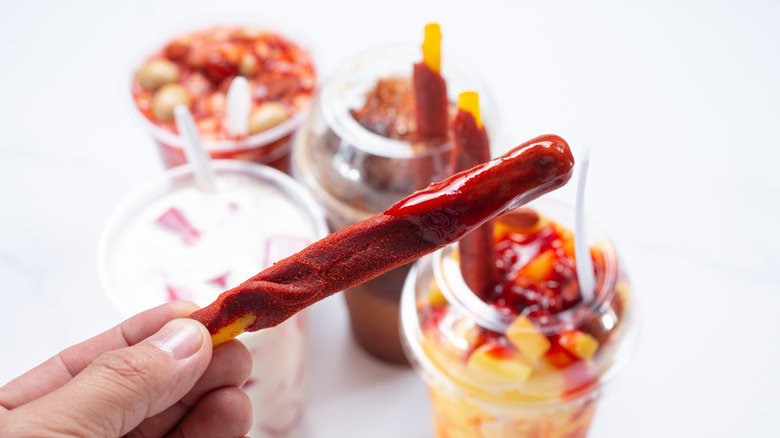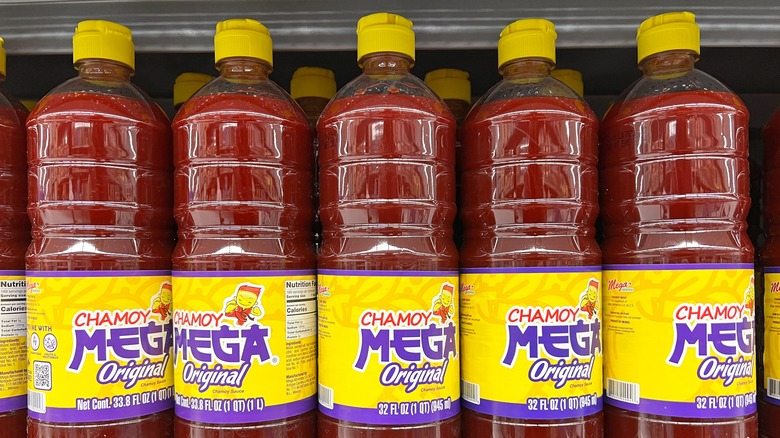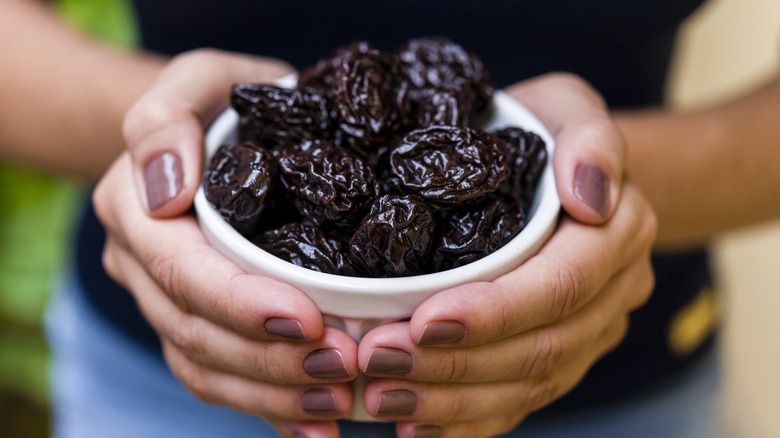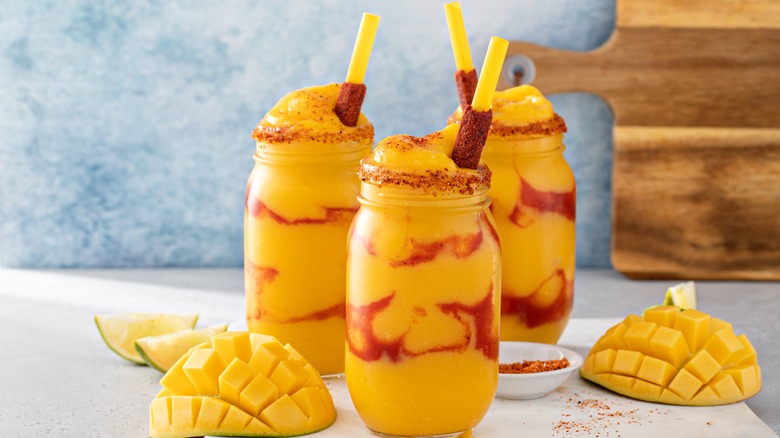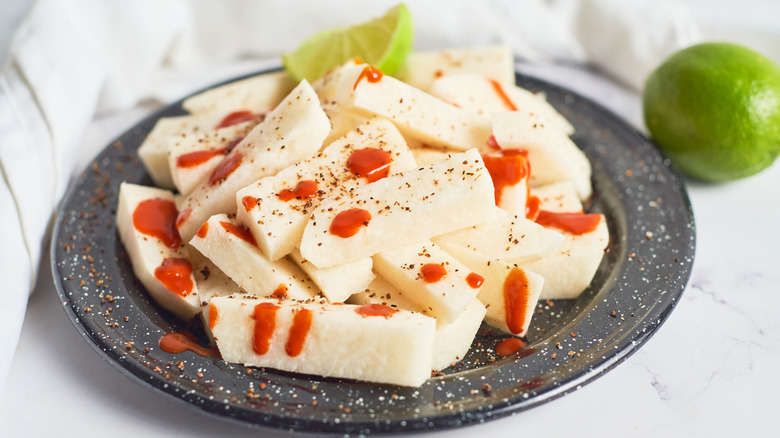What Is Chamoy And How Is It Best Used?
Bottled condiments are a convenient pantry staple — who doesn't want a hit of fiery hot sauce, or a spoonful of sweet Nutella ready to go? Although delicious, most of these bottled flavor bombs blast through only one flavor note.
The same can't be said about chamoy, which comes in a bottle reminiscent of hot sauce but delivers a broader range of flavors. Made with pickled fruit, dried chilies, citrus, and sugar, it runs the gamut of tastes: sweet, acidic, spicy, and salty.
Beloved as street food, it can be used to cover the rim of a cup of fresh fruit (especially mango) or to top a serving of corn. This sticky condiment is experiencing a renaissance, serving as a canvas for bold flavors and winding up in everything from tacos to cocktails and desserts. Plus, it's easy to prepare, though assembling the ingredients is the trickiest step. Let's dive into the details.
What is chamoy?
Bold chamoy sauce combines dried chilies and sugar atop a base of fruit — traditionally dried, salted, and pickled umeboshi plums. The inclusion of this particular preserved fruit may seem like an Asian influence, and that's because it is. Chamoy's precise origins are unknown, but the sauce is believed to have blossomed in Mexico by way of either Japanese or Chinese immigrants beginning in the 1950s and finding nationwide appeal by the 1990s. The rise of chamoy followed a similar trajectory as Hawaii's crack seed, which was also introduced to the region as an Asian import. Today, chamoy is especially intertwined with the state of Sinaloa, where there was an especially large number of arrivals from Asia.
The chamoy boom of the '90s was largely due to the onset of large-scale production, which popularized the condiment through multiple brands. These days, the sauce has experienced a major popularity boost. Chefs are altering its composition and bringing it to fine-dining settings, such as desserts at Enrique Olvera's restaurants.
How is chamoy made?
Chamoy can be made from an incredibly diverse range of ingredients — even the umeboshi can be swapped out. Nevertheless, the assembly always follows a similar format. First, the aromatic dried fruits like plums, apricots, and hibiscus are placed in a saucepan with water to rehydrate. Further seasonings like dried peppers — typically chiles de árbol — alongside sugar, tamarind paste, and salt are added to the mix. The flavors are allowed to infuse for a while, then the mixture is transferred to a blender where lime is incorporated. And finally, salt and sugar are sprinkled in to taste. The end result can be used right away or stored in a refrigerated container for up to three months.
While home preparation is becoming more common, many cooks pre-purchase the condiment. Chamoy can be readily found in Mexican groceries and increasingly in American stores, too. Look out for big brands as well as renditions by smaller producers — it's experiencing an expansion similar to hot sauce.
What to serve with Chamoy
Chamoy is most frequently used as a streetside condiment served alongside snacks and quick bites. It's typically poured onto dishes, like an ultra-flavor coating, or it can be used as a filling. Most uses are in the sweet realm, jolting confections with a spicy, sour flavor. In addition to candies, it works well with fresh produce, like mango, watermelon, apple, pineapple, guava, and more. And the condiment is beloved atop frozen applications, too, like paletas.
Chamoy's tang is welcome in cold drinks as well. When blended with mango and pineapple juice, it makes for a tasty frozen beverage called a chamoyada. Or, it can add a zingy note to a michelada, balanced with beer's easy-drinking flavor. Modern reinterpretations employ chamoy in cocktails, including margaritas and mezcal-based slings.
Although the sauce's palette leans sweet, some use the condiment in savory applications. On the street, it's mixed into esquites, which lends it a hot-sauce-like quality. It can even be used as a glaze prior to cooking, imbuing grilled meats with flavorful caramelization.
Other varieties of Chamoy
In addition to the classic hibiscus and umeboshi pairing, Chamoy can be used as a canvas for further dried-fruit sauces. For an easy-to-assemble version popularized by Rick Bayless, simply combine apricot jam, a Mexican hot sauce, and lime juice. Or, up the spice for savory applications by including ultra-spicy piquin chilies. Most alterations still include an apricot of some type — the fruit has a palatable body and sweetness.
However, chef Enrique Olvera chooses to instead serve a unique variant comprised of peaches. Other chefs change the acidic component, imbuing more of a tang through apple cider vinegar. Chamoy is ripe for ingredient substitution, and swapping out any of the core flavors still retains Chamoy's character. Having such a bold identity is precisely the sauce's appeal. It only takes a small drizzle to ignite a mouthful of flavor — it's no wonder the sauce has boomed in popularity.
